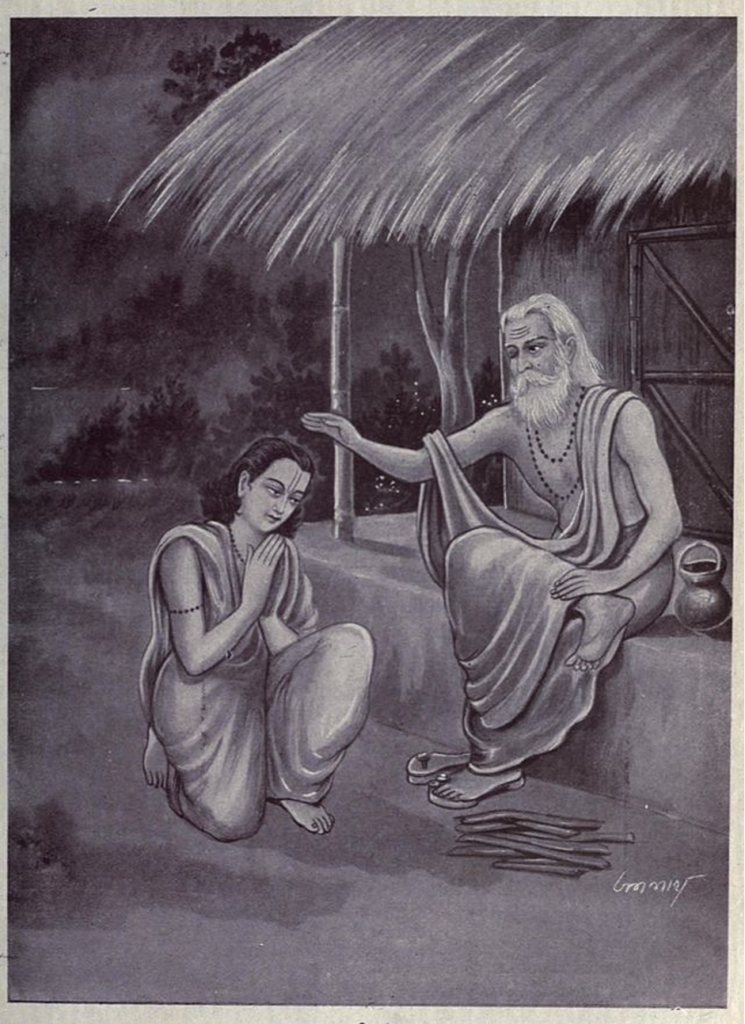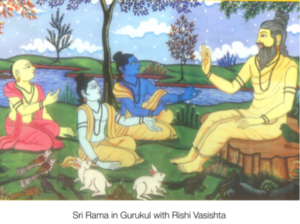
The word Guru has become a common and popular parlance with innumerable shades of meaning. It has gathered international recognition assuming different interpretations and linguistic liberties. In ancient Indian tradition though, a “Guru” was referred to as a master, who would help mentor students to transcend from tangible to intangible.
The meaning, value and teachings of a Guru were not restricted to mere ideological and theoretical concepts and techniques. The Guru was known primarily for his spiritual teachings intended for the positive evolution of humanity. Those giving scholastic training in different fields of disciplines like medicine, metallurgy, arts, economics, science & politics were referred to as Acharyas.
An ode to the Guru
The description of the word Guru is given in the text Guru Gita (the song of the Guru) a Hindu scripture attributed to Sage Vyasa, the compiler of Vedas and the venerated author of Puranas & Itihasa – Mahabharata. The text is believed to be part of Skanda Purana, largest of the Mahāpurāṇas, one of 18 great Puranas of the Hindu scriptures, with over 81,000 verses, the earliest text of which is believed to have been in existence around the 7nth century CE.
गुरुर्ब्रह्मा गुरुर्विष्णुर्गुरुर्देवो महेश्वरःI
गुरुरेव परं ब्रह्म तस्मै श्रीगुरवे नमःII
GururBrahma GururVishnuhu GururDevo Maheshwaraha
Gurureva Param Brahma Tasmai Shri Gurave Namaha
Gu represents darkness, ru means represents dispelling. Therefore, Guru is one who dispels the darkness. Darkness is likened to ignorance. Hence the Guru is one who removes this darkness by lighting the lamp of knowledge.
But this meaning alone is not enough for a complete understanding of the Guru.
The above verse is also dedicated to Shri. Govinda Bhagavadpada, the spiritual preceptor of the great seer & Advaita philosopher Shri Adi Shankaracharya. The chanting of this Stotra has been a part of Hindu culture for aeons.
In this famous Guru stotra- a hymn of praise, the Guru is looked upon not only as the Trinity; Brahma – the creator, Vishnu – the preserver, sustainer, Maheshvara (Siva) – the destroyer of unrighteous, but also the Self-revealing limitless Para Brahman (atma).
By invoking love for the teaching & dedication to study and service, the Guru becomes Brahma, the creator.
By his encouragement and care for the disciple, to sustain his interest and enthusiasm; the Guru becomes Vishnu, the protector
By guiding and defending the disciple against the obstacles in the perseverance of the study, the Guru become Maheshvara.
The fourth description, that Guru is Brahman (atma), reveals the profundity of his role. The Guru imparts knowledge about the consciousness, the limitlessness; that the teacher, the taught, and everything sentient and insentient is the Brahman (atma).
Guru transcends the physical dimension & the teaching sets the path to enlightenment. The eulogy of the Guru is mainly for the teaching as elucidated in the following verses from Gurustotram
अखण्डमण्डलाकारं व्याप्तं येन चराचरम् ।
तत्पदं दर्शितं येन तस्मै श्रीगुरवे नमः ॥
Akhandamannddalaakaaram Vyaaptam Yena Charaacharam I
Tatpadam Darshitam Yena Tasmai Shri Gurave Namah II
My salutations to the Guru who has shown me that pada; abode (atma), by which the whole universe (akhanda- mandalakaram) is pervaded.
अनेक जन्म सम्प्राप्त कर्म बन्ध विदाहिने l
आत्मज्ञान प्रदानेन तस्मै श्री गुरवे नमः ll
aneka janm samprāpta-karma bandhavidāhine |
ātmajñāna pradānena, tasmai śrīgurave namaḥ II
Salutations to that Guru, who by bestowing the knowledge of the
Salutations to that Guru who by bestowing the knowledge of the Self burns up the bondage created by accumulated actions of innumerable births. actions of innumerable (human) lives. (9)
The praise of the Guru transcends his physical form so that the disciple is able to overlook any inhibiting factors relative to his human form. In the cognitive process of understanding, he is absorbed in the Whole. The Guru creates an inner environment that enables the student to keep shedding his ignorance and see that he is divine, lacks nothing and is essentially complete. The knowledge to be gained is looked upon as universal, ultimate, and unequalled.
The path of the Guru is different from that of a mystic
A mystic can induce excitement or awe through his enigmatic personality or esoteric ways. He may or may not have a structured way of teaching the Truth. A Guru has a methodology of communication and a vision. So for one who wants to know the Brahman, the atma, that pervades everything, a Guru is indispensable.
The Guru is looked upon as a scholar srotriya, learned & wise, well versed in scriptures. He is also a brahma-nishta, who lives a life committed to the study of Brahma Vidya (atma Vidya) Self-Knowledge and is a source of inspiration to the spiritual seeker.
In the ancient methodology of teaching the Guru passes on his knowledge to the Sishya, the disciple, through oral traditions. The knowledge revealed is Vedanta, literally meaning the end portion of the Vedas that constitute the Upanishads. The teaching tradition by which this knowledge is unfolded is known as Sampradaya.
Here is a list of some, among several, illustrious thinkers and Vedanta teachers between 3000 B.C.E. and 1900 C.E (as generally surmised) who were the beacons of light through their spiritual and scriptural vision.
3000 B.C – Vyasa( Vedavyasa or Badarayana)
100 B.C -200 C.E – Upavarsha
300 – 600 C.E – Brahmadatta, Bhartrparpancha
700 C.E – Sundarapandya
800 C.E -Adi Shankaracharya, Sureshvara,Padmapada, Totaka, Hastamalaka
900 C.E -Vachaspatimishra
1000 C.E – Vimuktatman
1100 C.E -Prakashatmayati
1200 C.E – Sriharsha
1300 C.E -Amalananda, Citsukhacharya, Anandagiri
1400 C.E – Vidyaranya, Sankarananda
1500 C.E- Lakshmidhara
1600 C.E – Appayadikshita, Madhusudhana Saraswati
1700 C.E – Govindananda Saraswati, Ramananda Saraswati
1800 C.E – Achyutakrishnananda Tirtha, Sadashiva Brahmendra Sarasvati
1900 C.E- Anantakrishna Shastri, Upanishad Brahmnendra
Guru – Sishya Parampara
The subject matter imparted by the Guru to the student is about one’s own Self that is changeless and timeless. Therefore the teaching system- Sampradaya, is kept alive through a teacher-student lineage known as the Guru-Sishya Parampara. This tradition has a well-defined pursuit and a definite goal – Moksha, enlightenment. The instruction of the profound knowledge leading to enlightenment is transmitted by the Guru as an obligatory duty of love and responsibility for the spiritual progress of the students. The Sishyas, in turn, stays with the Guru for a particular period of time in a spirit of brotherhood with other disciples, humility and devotion to the Guru.

With the help of Guru’s words, group discussions, self-analysis and contemplation, the Sishyas are nurtured in an environment of peace and positivity that develops in them qualities of confidence, courage and conviction to absorb the knowledge. The inevitable part of the education of eternal knowledge through the succession of teacher-disciple or Guru Sishya Parampara is like the perennial flow of Ganga. The teachers and disciple may be limited by time, but the Sampradaya remains eternal.
Shri Krishna in Gurukul with Rishi Sandipani
Gurus in 21st Century
We now live in a world different from what it was in past. The internet has become an inseparable part of our lives. Multitasking by talking on a phone, switching TV channels, browsing the net, posting on social media can be done all at the same time. There are concepts such as WhatsApp universities, Youtube curriculums, Webinars and Zoom sessions, Skype classes, online courses. The good thing is that information has become much accessible with such technological advances and a plethora of Gurus are suddenly available.
A Guru needs to be a living master and the learning direct, at least for a certain period of time. The intellectual, emotional and spiritual bonding with the Guru, the reverence and reciprocation are irreplaceable. Knowledge of the consciousness cannot be looked upon as an academic accomplishment as the subject matter is about one’s own Self, about transcendence, from divisible to the indivisible from finite to the infinite. Even the formidable warrior Arjuna was taught the Bhagavad Gita only after he requested Sri Krishna to take him as his student, right in the middle of the battlefield.
Reference Books :
- Purna Vidya Vedic Heritage Teaching program by Swamini Pramananda Saraswati, Sri Dhira Chaitanya
- Prayer Guide by Swami Dayanananda Saraswati Arsha Vidya Gurukulam






Add comment